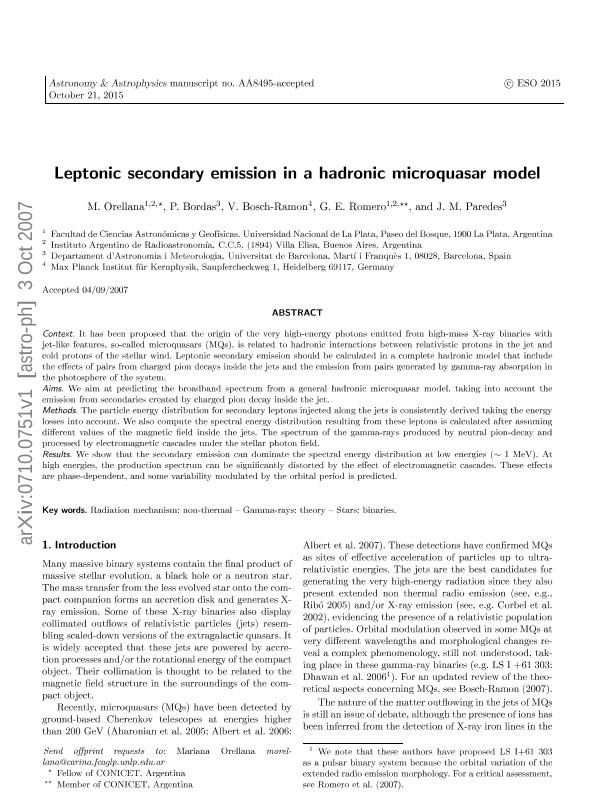Artículo
Leptonic secondary emission in a hadronic microquasar model
Orellana, Mariana Dominga ; Bordas, Pol; Bosch Ramon, Valentí; Romero, Gustavo Esteban
; Bordas, Pol; Bosch Ramon, Valentí; Romero, Gustavo Esteban ; Paredes, Josep Maria
; Paredes, Josep Maria
 ; Bordas, Pol; Bosch Ramon, Valentí; Romero, Gustavo Esteban
; Bordas, Pol; Bosch Ramon, Valentí; Romero, Gustavo Esteban ; Paredes, Josep Maria
; Paredes, Josep Maria
Fecha de publicación:
12/2007
Editorial:
EDP Sciences
Revista:
Astronomy and Astrophysics
ISSN:
0004-6361
Idioma:
Inglés
Tipo de recurso:
Artículo publicado
Clasificación temática:
Resumen
Context. It has been proposed that the origin of the very high-energy photons emitted from high-mass X-ray binaries with jet-like features, so-called microquasars (MQs), is related to hadronic interactions between relativistic protons in the jet and cold protons of the stellar wind. Leptonic secondary emission should be calculated in a complete hadronic model that include the effects of pairs from charged pion decays inside the jets and the emission from pairs generated by gamma-ray absorption in the photosphere of the system. Aims. We aim at predicting the broadband spectrum from a general hadronic microquasar model, taking into account the emission from secondaries created by charged pion decay inside the jet. Methods. The particle energy distribution for secondary leptons injected along the jets is consistently derived taking the energy losses into account. We also compute the spectral energy distribution resulting from these leptons is calculated after assuming different values of the magnetic field inside the jets. The spectrum of the gamma-rays produced by neutral pion-decay and processed by electromagnetic cascades under the stellar photon field. Results. We show that the secondary emission can dominate the spectral energy distribution at low energies ( ∼ 1 MeV). At high energies, the production spectrum can be significantly distorted by the effect of electromagnetic cascades. These effects are phase-dependent, and some variability modulated by the orbital period is predicted.
Palabras clave:
Radiation Mechanisms
,
Gamma Rays
,
Binary Stars
Archivos asociados
Licencia
Identificadores
Colecciones
Articulos(IAR)
Articulos de INST.ARG.DE RADIOASTRONOMIA (I)
Articulos de INST.ARG.DE RADIOASTRONOMIA (I)
Citación
Orellana, Mariana Dominga; Bordas, Pol; Bosch Ramon, Valentí; Romero, Gustavo Esteban; Paredes, Josep Maria; Leptonic secondary emission in a hadronic microquasar model; EDP Sciences; Astronomy and Astrophysics; 476; 1; 12-2007; 9-15
Compartir
Altmétricas



